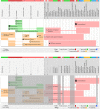Helping GPs to extrapolate guideline recommendations to patients for whom there are no explicit recommendations, through the visualization of drug properties. The example of AntibioHelp® in bacterial diseases
- PMID: 31077275
- PMCID: PMC7647204
- DOI: 10.1093/jamia/ocz057
Helping GPs to extrapolate guideline recommendations to patients for whom there are no explicit recommendations, through the visualization of drug properties. The example of AntibioHelp® in bacterial diseases
Abstract
Introduction: Clinical decision support systems (CDSS) implementing clinical practice guidelines (CPGs) have 2 main limitations: they target only patients for whom CPGs provide explicit recommendations, and their rationale may be difficult to understand. These 2 limitations result in poor CDSS adoption. We designed AntibioHelp® as a CDSS for antibiotic treatment. It displays the recommended and nonrecommended antibiotics, together with their properties, weighted by degree of importance as outlined in the CPGs. The aim of this study was to determine whether AntibioHelp® could increase the confidence of general practitioners (GPs) in CPG recommendations and help them to extrapolate guidelines to patients for whom CPGs provide no explicit recommendations.
Materials and methods: We carried out a 2-stage crossover study in which GPs responded to clinical cases using CPG recommendations either alone or with explanations displayed through AntibioHelp®. We compared error rates, confidence levels, and response times.
Results: We included 64 GPs. When no explicit recommendation existed for a particular situation, AntibioHelp® significantly decreased the error rate (-41%, P value = 6x10-13), and significantly increased GP confidence (+8%, P value = .02). This CDSS was considered to be usable by GPs (SUS score = 64), despite a longer interaction time (+9-22 seconds). By contrast, AntibioHelp® had no significant effect if there was an explicit recommendation.
Discussion/conclusion: The visualization of weighted antibiotic properties helps GPs to extrapolate recommendations to patients for whom CPGs provide no explicit recommendations. It also increases GP confidence in their prescriptions for these patients. Further evaluations are required to determine the impact of AntibioHelp® on antibiotic prescriptions in real clinical practice.
Keywords: antibiotics; clinical decision support system; clinical practice guidelines; infectious diseases; primary care; visualization.
© The Author(s) 2019. Published by Oxford University Press on behalf of the American Medical Informatics Association. All rights reserved. For permissions, please email: journals.permissions@oup.com.
Figures






Similar articles
-
A Web Interface for Antibiotic Prescription Recommendations in Primary Care: User-Centered Design Approach.J Med Internet Res. 2021 Jun 11;23(6):e25741. doi: 10.2196/25741. J Med Internet Res. 2021. PMID: 34114958 Free PMC article.
-
Towards evidence-based CDSSs implementing the medical reasoning contained in CPGs: application to antibiotic prescription.Stud Health Technol Inform. 2014;205:13-7. Stud Health Technol Inform. 2014. PMID: 25160136
-
How do general practitioners access guidelines and utilise electronic medical records to make clinical decisions on antibiotic use? Results from an Australian qualitative study.BMJ Open. 2019 Aug 5;9(8):e028329. doi: 10.1136/bmjopen-2018-028329. BMJ Open. 2019. PMID: 31383702 Free PMC article.
-
Physicians' Attitudes Towards the Advice of a Guideline-Based Decision Support System: A Case Study With OncoDoc2 in the Management of Breast Cancer Patients.Stud Health Technol Inform. 2015;216:264-9. Stud Health Technol Inform. 2015. PMID: 26262052
-
[Scientific evidence and antimicrobial therapy: A perfect couple?].Enferm Infecc Microbiol Clin. 1999;17 Suppl 2:9-14. Enferm Infecc Microbiol Clin. 1999. PMID: 10605184 Spanish.
Cited by
-
Clinical Decision Support Systems for Antibiotic Prescribing: An Inventory of Current French Language Tools.Antibiotics (Basel). 2022 Mar 14;11(3):384. doi: 10.3390/antibiotics11030384. Antibiotics (Basel). 2022. PMID: 35326847 Free PMC article.
-
What rationale do GPs use to choose a particular antibiotic for a specific clinical situation?BMC Fam Pract. 2019 Dec 20;20(1):178. doi: 10.1186/s12875-019-1068-7. BMC Fam Pract. 2019. PMID: 31862003 Free PMC article.
-
Development of explicit definitions of potentially inappropriate prescriptions for antidiabetic drugs in patients with type 2 diabetes: A multidisciplinary qualitative study.PLoS One. 2024 Sep 27;19(9):e0309290. doi: 10.1371/journal.pone.0309290. eCollection 2024. PLoS One. 2024. PMID: 39331645 Free PMC article.
-
Need for innovation in electronic health record-based medication alerts.J Am Med Inform Assoc. 2019 Oct 1;26(10):901-902. doi: 10.1093/jamia/ocz155. J Am Med Inform Assoc. 2019. PMID: 31529124 Free PMC article. No abstract available.
-
A Web Interface for Antibiotic Prescription Recommendations in Primary Care: User-Centered Design Approach.J Med Internet Res. 2021 Jun 11;23(6):e25741. doi: 10.2196/25741. J Med Internet Res. 2021. PMID: 34114958 Free PMC article.
References
-
- Davey PG, Marwick C.. Appropriate vs inappropriate antimicrobial therapy. Clin Microbiol Infect 2008; 14 (Suppl 3): 15–21. - PubMed
-
- Gupta K, Hooton TM, Naber KG, et al. International clinical practice guidelines for the treatment of acute uncomplicated cystitis and pyelonephritis in women: A 2010 update by the Infectious Diseases Society of America and the European Society for Microbiology and Infectious Diseases. Clin Infect Dis 2011;52:e103–120. doi:10.1093/cid/ciq257. - PubMed
-
- Pulcini C, Williams F, Molinari N, et al. Junior doctors’ knowledge and perceptions of antibiotic resistance and prescribing: a survey in France and Scotland. Clin Microbiol Infect 2011; 171: 80–7. - PubMed
Publication types
MeSH terms
Substances
LinkOut - more resources
Full Text Sources
Medical

